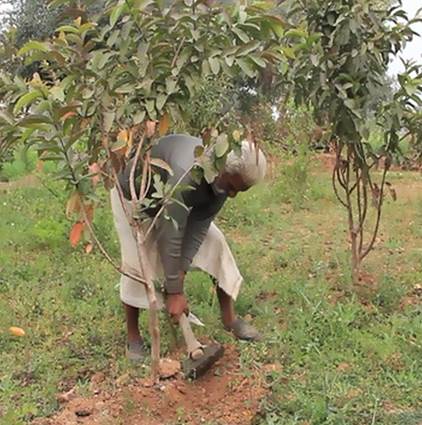|
Wadi – Small Farms, Big Returns
I n the poor and backward region of Bundelkhand in Central India, 67% of the farmers are small scale and marginal farmers who own less than two hectares of land. Agriculture as practiced by these small scale farmers is mostly of subsistence nature and employs conventional methods that result in low levels of productivity. With the added impact of drought, agriculture on small farms has been rendered unviable leading to distress migration in search of wage labour employment. Available data suggests that as much as 40% of the population migrates every year. This means that a significant percentage of small farms are left fallow and not put to productive use and which over time and continued neglect get degraded into unproductive wasteland.With about 90% of the population being dependent on
agriculture for their livelihoods and 75% of agriculture being rain-fed
and thus susceptible to erratic monsoon and weather patterns, climate
adaptive agricultural development emerges as a crucial economic
development strategy for the region. |
|
|
|
Wadi, an agro-horti based livelihood development model provides an effective solution in this context. The model ensures improved farm productivity and returns making agriculture a viable option even on small farms owned by marginal farmers. This Wadi model reduces climate risks, regenerates the production potential of the land and demonstrates tremendous potential as a pathway out of poverty for small scale and marginal farmers. Key features of the Wadi model are given below: Approach - Sound Application of Agriculture Science The Wadi model is based on agri-horti inter-cropping i.e. plantations of fruit trees with the space between the trees used for cultivating seasonal crops. The crops are selected to ensure crop rotation. One leguminous crop is planted each year to enrich soil nitrogen. The selection of appropriate orchard species is based on the analysis of soil type, slope and drainage. High yielding varieties are promoted for improved production. As the fruit trees grow, the growing canopy also influences the micro-climate making it possible to grow shade loving high value crops. A Better Economic Deal for Farmers The viability of the Wadi model as a business has been proven. The cost of establishing a Wadi is about INR 45,000. The returns in the first three years are only from the seasonal crops and range between INR 10000 -15,000 each year. The fruit trees take about four years to mature and start yielding harvests becoming an extra revenue stream. By the 7 th year, the farm returns increase to at least INR 50,000 - 60,000 each year.Rejuvenates the Local Ecology The land and water management practices that form an integral component of the Wadi model lead to a host of ecological co-benefits such as improved organic content and thereby the water holding potential of the soil, enhanced ground water recharge and reduced soil erosion losses. The plantation of trees leads to significant carbon sequestration. Established as clusters, Wadis also impact the micro-climate leading to improved local biodiversity. The use of organic fertilisers and pesticides and practices leads to gradual improvement in soil organic content and water holding capacity. Water resource development and improved water management techniques such as selection of water efficient crops and irrigation systems ensures that adequate water is available for three crops a year. The Wadi model is climate resilient and can be adopted on partially degraded lands on which conventional agriculture is not possible. It thus represents a solution for reclaiming degraded lands into productive use leading to both economic and ecological benefits. Development Alternatives has helped set up Wadis with over 1000 small scale and marginal tribal farmers in Bundelkhand with the support of the Government of India. It is not only an economic development model for agriculture development but also presents solutions for food security and regeneration of local ecosystems – a true case for triple bottom line wellbeing. q Chitrangna Dewan
|
